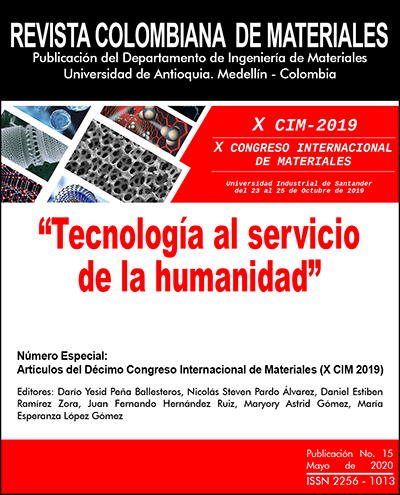Análisis del comportamiento mecánico de bandas de resistencia como sustituto de la piel humana en ensayos mecánicos
DOI:
https://doi.org/10.17533/udea.rcm.342057Palabras clave:
piel humana, piel de cerdo, bandas de resistencia, ensayo uniaxial, hiperelasticidadResumen
La piel humana es un tejido multicapa altamente anisotrópico, el análisis de sus características ha sido estudiando por años con el fin de encontrar un modelo definitivo que describa su comportamiento. Actualmente se necesitan modelos y sustitutos para suplir las necesidades de simuladores quirúrgicos y en industrias como los video juegos y la animación. En este estudio se usaron muestras de piel de cerdo adquiridas en una tienda local debido a las similitudes entre la piel de cerdo y la piel humana. Se seccionaron tres muestras de 60 mm x 120 mm a las que se le removió la hipodermis y fueron evaluadas en una máquina universal Shimadzu AG-X. Teniendo como referencia los ensayos realizados en la piel de cerdo, se estima la viabilidad de las bandas de resistencia elaboradas de látex como sustituto mecánico de la piel humana. Se realizaron ensayos de tracción en siete diferentes bandas de resistencia (su rigidez está definida por el color) utilizando un perfil C de acuerdo con la norma ASTM D412. Tanto para las muestras de piel de cerdo como para las bandas de resistencia se obtienen las constantes para el modelo hiperelástico de Veronda Westman usando la Suite FEBio. Empleando la energía de deformación como factor comparativo, se determinó que las bandas de resistencia elaboradas de látex no podrían reemplazar la piel humana en los escenarios y aplicaciones descritas anteriormente.
Descargas
Citas
Derler, S. and Gerhardt, L. C., “Tribology of Skin: Review and Analysis of Experimental Results for the Friction Coefficient of Human Skin,” Tribol Lett, vol. 45, no. 1, pp. 1–27, Jan. 2012.
Limbert, G. et al., “Biotribology of the ageing skin—Why we should care,” Biotribology, vol. 17, pp. 75–90, Mar. 2019.
Limbert, G., “Mathematical and computational modelling of skin biophysics: a review,” Proceedings of the Royal Society A: Mathematical, Physical and Engineering Sciences, vol. 473, no. 2203, p. 20170257, Jul. 2017.
Leyva-Mendivil, M. F., Lengiewicz, J., Page, A., Bressloff, N. W. and Limbert, G., “Skin Microstructure is a Key Contributor to Its Friction Behaviour,” Tribol Lett, vol. 65, no. 1, p. 12, Jan. 2017.
Zhong, W., Xing, M. M. Q., Pan, N.,and Maibach, H. I.,“Textiles and human skin, microclimate, cutaneous reactions: An overview,” Cutaneous and Ocular Toxicology, vol. 25, no. 1, pp. 23–39, 2006.
Schwartz, D., Magen, Y. K., Levy, A., and Gefen, A., “Effects of humidity on skin friction against medical textiles as related to prevention of pressure injuries,” Int Wound J, vol. 15, no. 6, pp. 866–874, Dec. 2018.
Carlson, J. M., “Functional limitations from pain caused by repetitive loading on the skin: A review and discussion for practitioners, with new data for limiting friction loads,” JPO: Journal of Prosthetics and Orthotics, vol. 18, no. 4, pp. 93–103, 2006.
Sopher, R. and Gefen, A. “Effects of skin wrinkles, age and wetness on mechanical loads in the stratum corneum as related to skin lesions,” Med Biol Eng Comput, vol. 49, no. 1, pp. 97–105, Jan. 2011.
Tran, H. V., Charleux, F., Rachik, M., Ehrlacher, A., and Tho, M. C. Ho Ba, “In vivo characterization of the mechanical properties of human skin derived from MRI and indentation techniques,” Computer Methods in Biomechanics and Biomedical Engineering, vol. 10, no. 6, pp. 401–407, 2007.
Gerhardt, L.-C., Strässle, V., Lenz, A., Spencer, N. D., and Derler, S., “Influence of epidermal hydration on the friction of human skin against textiles,” Journal of the Royal Society Interface, vol. 5, no. 28, pp. 1317–1328, 2008.
Lapeer, R. J., Gasson, P. D., and Karri, V., “A hyperelastic finite-element model of human skin for interactive real-time surgical simulation,” IEEE Transactions on Biomedical Engineering, vol. 58, no. 4, pp. 1013–1022, 2011.
Lapeer, R. J., Gasson, P. D., and Karri, V., “Simulating plastic surgery: From human skin tensile tests, through hyperelastic finite element models to real-time haptics,” Progress in Biophysics and Molecular Biology, vol. 103, no. 2–3, pp. 208–216, 2010.
Renvoise, J., Burlot, D., Marin, G., and Derail, C., “Adherence performances of pressure sensitive adhesives on a model viscoelastic synthetic film: A tool for the understanding of adhesion on the human skin,” International Journal of Pharmaceutics, vol. 368, no. 1–2, pp. 83–88, 2009.
Derler, S., Schrade, U. and Gerhardt, L.-C. “Tribology of human skin and mechanical skin equivalents in contact with textiles,” Wear, vol. 263, no. 7–12, pp. 1112–1116, Sep. 2007.
Lim K. H., et al., “New extensometer to measure in vivo uniaxial mechanical properties of human skin,” Journal of Biomechanics, vol. 41, no. 5, pp. 931–936, 2008.
Shergold, O. A., Fleck, N. A., and Radford, D., “The uniaxial stress versus strain response of pig skin and silicone rubber at low and high strain rates,” International Journal of Impact Engineering, vol. 32, no. 9, pp. 1384–1402, Sep. 2006.
Martins, P., Natal Jorge, R. M., and Ferreira, A. J. M., “A Comparative Study of Several Material Models for Prediction of Hyperelastic Properties: Application to Silicone-Rubber and Soft Tissues,” Strain, vol. 42, no. 3, pp. 135–147, 2006.
ASTM, ASTM D412-06a(2013), Standard Test Methods for Vulcanized Rubber and Thermoplastic Elastomers—Tension. West Conshohocken, PA,: ASTM International, 2013.
Veronda, D. R., and Westmann, R. A., “Mechanical characterization of skin—Finite deformations,” Journal of Biomechanics, vol. 3, no. 1, pp. 111–124, Jan. 1970.
Maas, S. A., Ellis, B. J., Ateshian, G. A., and Weiss, J. A., “FEBio: Finite Elements for Biomechanics,” J Biomech Eng, vol. 134, no. 1, pp. 011005-011005–10, Feb. 2012.
Descargas
Publicado
Cómo citar
Número
Sección
Licencia
Derechos de autor 2020 Revista Colombiana de Materiales

Esta obra está bajo una licencia internacional Creative Commons Atribución-NoComercial-CompartirIgual 4.0.








